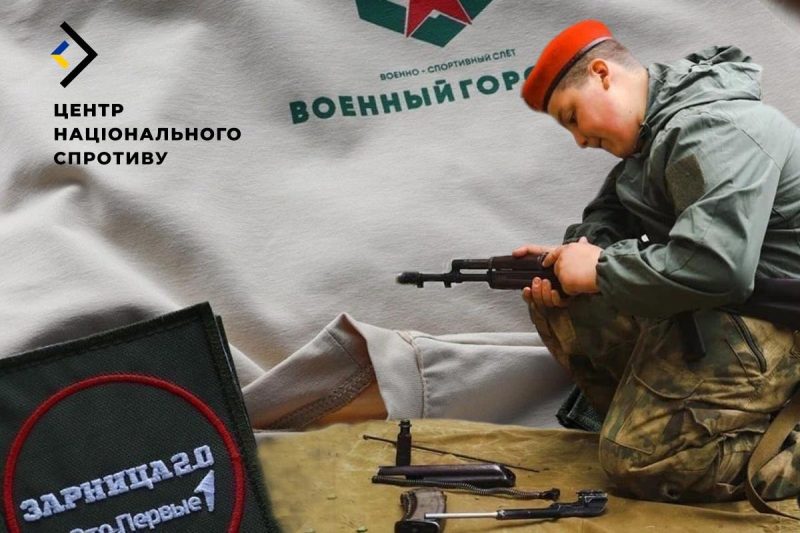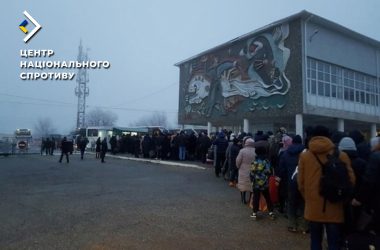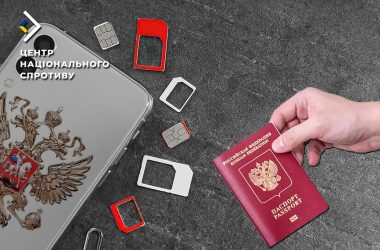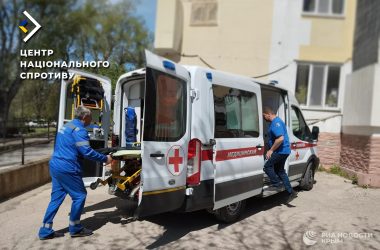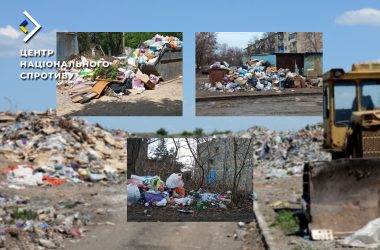This year, the invades have engaged thousands of Ukrainian children in all occupied territories to participate in the transformed military-patriotic game Zarnitsa. While last year, when the “Zarnitsa 2.0” project was just being piloted, only a few groups of children from Ukraine were involved, this year hundreds of “squads” have been formed.
Thousands of Ukrainian children were forced to undergo centralized online registration. Hundreds of children will be taken outside of Ukraine for military training in the summer, which is expressly prohibited by the Geneva Convention. What kind of “game” is this and what threat it poses in the occupied territories, explains retired Armed Forces major and youth policy expert Yurii Yuzych
A pilot version based in Moscow and the region
In March 2023, the “Movement of the Firsts”, created less than a year earlier to mark the 100th anniversary of the pioneering organization, announced its intention to update the Soviet game “Zarnitsa” (Ukrainian: “Zagrava”). It was announced that a test version of the game would first be implemented in several regions and then launched nationwide. As part of the pilot in 2023, it was planned to involve about 10,000 children, of whom 1,500 will meet at the all-Russian final, which will be held in the format of a TV show with a storyline.
“The tests will include work in an exoskeleton, drone control, VR technologies, pre-hospital care in stressful situations, fireworks, fighting fakes, actions in an emergency, and terrain orientation,” said Grigory Gurov, head of the “Firsts Movement”, former Minister of Higher Education and Science and former youth leader of Stavropol Region, at the presentation of the initiative. He also noted that “Zarnitsa 2.0” should “become an important element of patriotic education” and cover the age group of 11 to 21 years old.

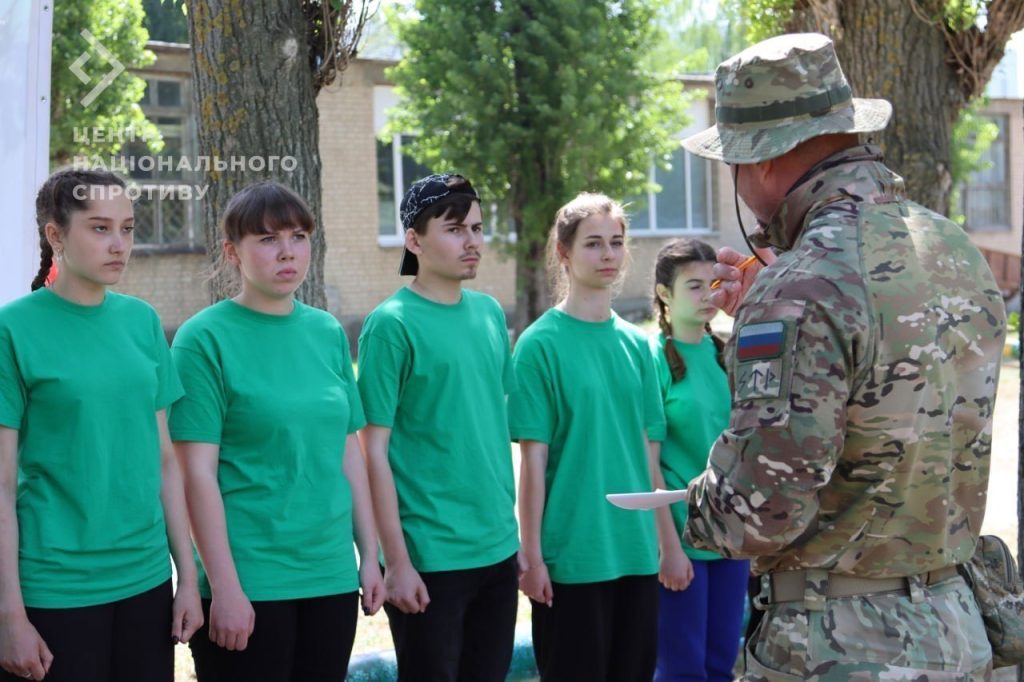
The pilot version of the game was held in Moscow. It included 125 participants aged 15-16 who had undergone intensive training at the Russian Technological University – MIREA (yesterday’s wards of Gurov). The instructors of the Warrior Center taught the children the basics of tactical medicine, military topography, firearms, engineering and tactical training, and drone control skills. The rules were monitored by 40 specially trained instructors and the same number of “experienced game technicians.”
The previous training for these children ended in the summer of 2023, when “Movement of the Firsts” organized the final camp for them, which took place on July 19-21 in the Moscow region at the “Borodino Field” Museum and Reserve. The children competed in teamwork, orienteering, drone control, and first aid at this camp. First Deputy Head of the Presidential Administration Serhiy Kiriyenko came to evaluate the successes personally. This curator of the “Warrior Center” then outlined the goals of the renewed “Zarnitsa”:
“First of all, it is a high technological level, real training in handling modern equipment. Most importantly, it fosters a sense of teamwork that requires courage and endurance, patriotism, and demonstrates the continuity of the best traditions. The history of “Zarnitsa” in our country has never stopped, and today the “Firsts Movement” is actively working in this direction. It is very important that the boys have the opportunity to compete and be proud of what they can do.”
The first 11 regional stages
Back at the “Borodino Field” in July 2023, Grigory Gurov announced that the following month, regional stages of the game would be held in 11 regions: the Republic of Buryatia, Yamalo-Nenets Autonomous District (YaNAO), Sverdlovsk, Belgorod, Kemerovo, Tyumen, Pskov regions, Khabarovsk Kray, Republic of Kalmykia, the Republic of Tatarstan, and the Chechen Republic. These finals were held as part of the specialized camp shifts “Time of Heroes” organized by the “Warrior” Center.

By the end of 2023, “Movement of the Firsts” planned to develop a unified “Zarnitsa 2.0” standard covering grades 5-7, high school students, and students under 21, to be extended to all regions next year. At one of the pilot 12 regional finals of “Zarnitsa 2.0.”, held in the Sverdlovsk region, during the third camp shift, Time of Heroes, qualifying rounds were held with more than 250 cadets participating.
The four best squads of 15 people each were allowed to participate in “Zarnitsa 2.0.” The participants are aged 14-17. All of them are students of the third camp shift, “Time of Heroes”, organized by a branch of the Warrior Center, and represent different cities in the Sverdlovsk Region. One of the finals of “Zarnitsa” 2.0 also featured a team from the occupied territories of Ukraine – a group of children from Luhansk Oblast who were involved in a shift at the “Warrior Center” in Volgograd Oblast.
The all-Russian finals of “Zarnitsa 2.0” for the winners of the previous game stages were scheduled to take place in Nizhny Novgorod in September. Teams from the respective regions where the “Warrior Center” held its Time of Heroes camp sessions were to travel there. The regional delegations included the winners of the respective stages and the “best students” from the “Warrior Center” camp shifts held in the region.
On September 22-28, the Nizhny Novgorod region hosted the final game “Zarnitsa: Legends of the Future”. Teams from Moscow and the Moscow region, the Donetsk People’s Republic, and the other 11 regions where the project was implemented came to the village of Istomino, where the competition took place. All 225 participants were divided into two teams – the Reds and the Greens. They performed several tactical tasks, following a scenario: using radios, crossing minefields, destroying enemy vehicles, and flying drones.
An additional pilot in the Belgorod region
In the first days of November last year, it was reported that the “DPR” team had won silver at the pilot competition “Zarnitsa 2.0: Time of Heroes!” in the Belgorod region. 14 teams of 20 boys aged 14-17 competed in a field camp in the Chernyansky district, once inhabited by Ukrainian immigrants. All teams, except for the children from the “DPR,” were formed by cadets from the regional “Warrior” centers. The challenges included the Encryption block, crossing, reconnaissance, a historical quest, and more. The game’s legend was developed considering the standards and approaches of a similar game at the federal level.
“The competitions were held in conditions as close to reality as possible: the guys solved various ‘combat’ tasks, including as scouts, orienteering, searching for a cache, and rescuing the ‘wounded’. There was also a “counter battle,” said Pushilin, the ‘leader of the DPR,’ afterward. In this game, as in the previous ones, there were several sides at once, which were marked with different colors. That is, children are being trained to fight several enemies at once.
Based on the results of the piloting of “Zarnitsa 2.0.” in 2023, it was decided that next year the game would be held in the spring in each municipality, followed by regional competitions. In the fall of 2024, it was also planned to launch a second wave of competitions in three stages: at the level of villages, cities, districts, and the region (they have not yet been announced). This year’s “Zarnitsa 2.0” was also decided to include training sessions using 450 unmanned aerial vehicles and 1,500 sets of laser tag equipment.
“The skills to be mastered by the participants include countering cyber threats and using UAVs, as they are needed not only on the battlefield but are also indispensable for searching for missing persons, in engineering and reconnaissance work, logistics, firefighting, and so on. To master these skills, we have created a UAV operator simulator based on domestic software,” said Gurov.
According to him, a special asynchronous training course has been developed for the successful completion of the tests. It includes training videos and tests prepared by experts in orienteering, drone control, fire training, medicine, and rescue.
The concept of the 2024 game
This year, the game was expected to be organized by the Movement of the First, which declares that “more than 43 thousand branches of the movement operate regularly in 89 regions of Russia” and “more than 5 million people are members of the movement.” The partners of “Zarnitsa 2.0.” officially include the Warrior Center for Military Sports Training and Patriotic Education of Youth, the Russian Society “Znanie”, Yunarmiya, the All-Russian Student Rescue Corps (VSKS), the MIREA Special Training Center, and the Russian Historical Society.
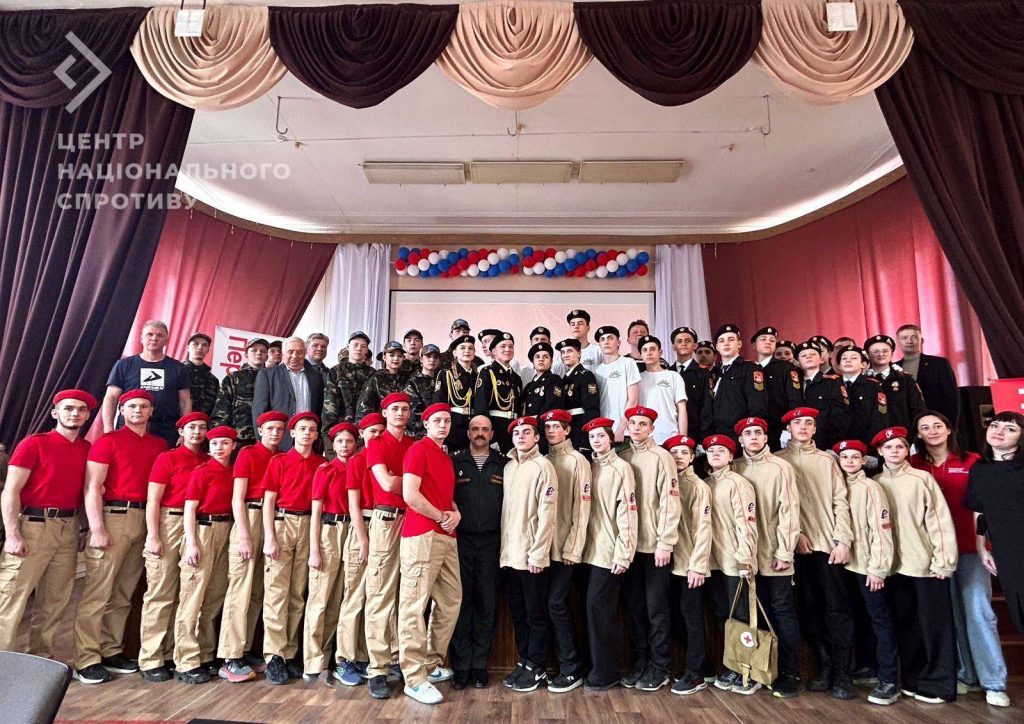
The official goal of the game is stated as follows: “to lay a solid foundation for patriotic consciousness among children and youth and to increase interest in the history of the fatherland and the armed forces of the Russian Federation.” In the regions, however, another goal of “Zarnitsa 2.0” can be read: “to foster team spirit and mutual assistance in the participants, to instill love for their country, pride in its achievements, and to provide the necessary skills for life – from first aid to knowledge of cybersecurity rules.”
“Zarnitsa 2.0” is organized in several stages: a qualifying stage based on educational institutions, municipal and regional stages, a district semi-final (for the occupied Ukrainian regions – in Volgograd) and an all-Russian final. The tests of the first stage depend on the age of the participants. For example, the middle and senior groups will have to pass drill and sports training, general military literacy, tests on knowledge of national history, and first aid. The younger group will participate in a review of the formation and song, the “Heroes in Uniform” quiz, the “Sniper” sports game and the Zarnitsa 2.0 route game.
For example, in Crimea, the teams completed tasks at 7 stations: “Militarized obstacle course”, “Fire training”, “Drill training”, “RCBD basics”, “Knowledge of national history”, “General physical training according to TRP standards”, “First aid (”Tactical medicine and self-help“)”. The test program for the middle-aged group included Knowledge of National History, Sports Training, Drill Training, First Aid, Militarized Obstacle Course, and Fundamentals of Radiation, Chemical, and Biological Defense.
Participants of “Zarnitsa 2.0”
All participants had to register on the game’s website to participate in the first (qualifying) stage by March 31, 2024. As of April 2, 2024, there were just over 350,000 participants, and by the deadline a week later, there were already over 800,000. “Anyone from 7 to 17 years old could register.” “After logging into their account, participants can choose their digital avatars created using a neural network, as well as choose a call sign.”
Participants under the age of 18 were registered as “fighters” and those over 18 as “mentors.” Depending on the role, the user was offered a questionnaire to fill out. A “mentor” could also create a squad and invite “fighters” to join it. The “mentor” of the squad was usually a teacher or legal representative of one of the students. He also ensured that each child had the appropriate parental permission (and in Ukraine’s occupied territories, too).
Participants under the age of 18 were registered as “fighters” and those over 18 as “mentors.” Depending on the role, the user was offered a questionnaire to fill out. A “mentor” could also create a squad and invite “fighters” to join it. The “mentor” of the squad was usually a teacher or legal representative of one of the students. He also ensured that each child had the appropriate parental permission (and in Ukraine’s occupied territories, too).
The system automatically divided participants into age categories during registration. Each team had to have at least two girls. Each participant chose their own specialization. For example, in Sevastopol, the boys, depending on their skills, chose the following roles as “fighters”: assault pilot, sapper, political officer, topographer, UAV operator, medic or military commander. The most responsible and “ready to make decisions” became squad leaders.
It was planned that each squad would be able to follow the team’s performance in the federal ranking, but in practice this idea was not implemented. It is not yet known to what extent another idea to involve veterans of the war in Ukraine in the game has been implemented. Back on February 15, Hryhoriy Gurov, Chairman of the Board of the “Firsts Movement”, and Hanna Tsyvilyeva, Head of the “Defenders of the Fatherland” Foundation, signed a long-term cooperation agreement.
The document provides for organizing joint events and implementing projects aimed at patriotic education of children and youth. “The veterans of the war against Ukraine will become lecturers, mentors, and methodologists for such flagship projects of the First Movement as Keepers of History and “Zarnitsa 2.0”, share their skills and experience with the boys, and become an important moral guide for them,” said Hurov.
“The Movement of the Firsts” declares that over 3,300 regional municipalities have applied to host “Zarnitsa 2.0.” this year. After the game’s first stage was implemented on May 14 this year, “more than 25 thousand schoolchildren and students of secondary vocational education institutions across Russia began the first tasks of the regional stage.” That is the children who completed the municipal stages in their cities and reached the quarterfinals, which lasted until the end of May. The winning teams of this stage will go to field camps for three weeks.
Crimea and Sevastopol
In Simferopol alone, 18 teams arrived at the regional stage of the older “Zarnitsa 2.0” age group, which began on May 19. Almost two hundred children were primarily involved in the First Movement. Including the junior and middle school groups, we can assume that more than 500 children were brought to the “republican” competitions. For example, the “honor and dignity” of the Nizhnegorsk district in the 14-17 year-old age group was “defended” by the “Patriot 1941” unit from Nizhnegorsk School-Lyceum No. 1, and in the middle group (12-13 years old) by the “First Battalion” unit from Perlynka School.
In Sevastopol, the “regional” competition occurred at the end of April. The stadium brought together 12 teams from different districts of the city. That is 3 teams from each district (one in each age group) that had already passed the municipal qualifying stage. The competition was attended by Sevastopol “activists” – students of gymnasiums No. 7 and 10, schools “Ecotech+”, No. 4, 6, 9, 2, 25, 33, 58, 60, 61. At the previous level, the district level, the competition involved about 1000 children. In particular, 270 children in 27 teams competed in the 11-23 age group.
Anna Molchanova, head of the regional branch of the First Movement in Sevastopol, emphasized: “This is a new format of the event… because the efforts of all patriotic organizations working with children are aimed at ensuring that they acquire new skills that will be useful to them in life.” “Zarnitsa” consolidates various of Putin’s paramilitary projects into one umbrella project. Ivan Demidov, director of the Center for Military and Patriotic Education of Student Youth, a co-organizer of the competition, states: “The game has existed in Sevastopol for a long time, but [for the first time] we are joining the All-Russian space.”
Donetsk region
The qualifying rounds of “Zarnitsa” in the occupied territories of Donetsk Oblast started on February 23, the “Day of the Defender of the Fatherland” along with other regions of the Moscow Empire. The project participants were children from 8 years old and teenagers up to 17 years old in three age categories: junior, middle, and senior. “Children from all over the “DPR” participated.” However, there are obvious problems with children in the “republic”. Unlike the “all-Russian” competitions, where teams consisted of 10 people, in the “DPR” they were formed of only 5 children. One of the occupiers’ resources reported on the qualifying stages of “Zarnitsa” in Donetsk: “all ten (sic!) schools of Donetsk take part in the competition”. Before the occupation, there were 169 schools in the city…
On May 30, the regional stage of “Zarnitsa 2.0.” was held in Mariupol, at school 28 (before the occupation, the Ivan Sirko game hut “Dzhura” was located there). The event was attended by 20 teams from 12 cities of the ‘republic’. The occupiers claim that these were “activists” of their youth organizations “Yunarmiya” and “The Firsts Movement”, in particular, from Kirovske, Khartsyzsk, Mangush, Novoazovsk and Horlivka. Municipal qualifying rounds were also held in Starobeshev, Shakhtarsk, Telmanove, and Volodarsk. Children from Novoazovsk took 1st place in the middle-age category and 3rd place in the senior-age category. The first place in the senior age group went to a team from Horlivka’s 52nd school.
The young men competed and demonstrated their skills in drill, sports, complex firearms, and engineering and sapper training. At the end of the competition, a military-patriotic game with laser tag was held. The regional stage was organized with the support of the “Ministry of Youth Policy” and “The Ministry of Education and Science”, the “Department of Social Support for Retired Servicemen and Patriotic Education” under the “Head of the DPR”, as well as the “Warrior” Center, which was not officially declared in Donetsk, “Yunarmiya”, “DOSAAF, VSKS and RSM”.
Luhansk region
In the “Luhansk People’s Republic”, the invaders declared that more than 3,000 ‘activists’ from the “Movement of the Firsts” took part in the municipal stage of the “Zarnitsa 2.0” game in March-April 2023, competing in 21 municipalities. More than 150 teams of 10 to 50 people were formed. In the Luhansk region, the occupiers have been regularly holding their own “Zarnitsa” game since 2019, and when the Kremlin leaders issued an instruction about the “all-Russian” game, they quickly transformed their local initiative.
Competitions in the “LPR”, as well as throughout the empire, were held in three age categories: among participants aged 8-10, 11-13, and 14-17. In Lutuhyne, where a “Plast” branch was operating before the occupation, the ” Zarnitsa ” municipal stage was held at the Metallurg Stadium. Similar qualifying competitions were held in other cities. In total, the invaders declare more than half a thousand “Movement of the Firsts” in the “LPR”, including more than 20,000 children. But they can’t actually involve them in the game because even in their declarations, they talk about only 15% of this number.
As a result, 16 teams of different age categories with a total of 250 children entered the “republican” stage on May 31, 2024. “The competitions were held gradually, over five days, to protect the participants and avoid massive crowds.” Everything took place based on the “Republican Cossack Cadet Corps named after Air Marshal Alexander Yefimov”. As in the “DPR,” the competitions were supported by the “ministries” of youth (separate from sports) and education, the “Warrior” center, and the “Yunarmiya.” Involvement: “Center for the Development of Children and Youth Movement in the LPR”, regional branches of the “Young Guard of United Russia” and the “Youth Wing of the Popular Front”.
Zaporizhzhia region
“Zarnitsa 2.0” involved more than 200 participants in 32 teams created based on the branches of the First Movement and the “Yunarmiya” (which does not correlate with the invaders’ claim of ‘thousands of children’ involved in ‘hundreds’ of branches of these structures in the region). The municipal stages took place simultaneously in Melitopol and Berdiansk on April 27-28. Afterwards, the invaders stated that “students of youth movements in the region took part in this large-scale event”. This means that the initial qualifying stage was not held based on educational institutions.
“The game began with welcoming words from the organizers and partners, the Russian anthem and the raising of the national flag. Then the game’s rules were explained to the young Zaporizhzhia residents and the boys started to complete the tasks. The game was held in 7 locations where the boys tested their theoretical knowledge, first aid skills, drill and sports training, use of chemical protection equipment and overcoming the obstacle course.”
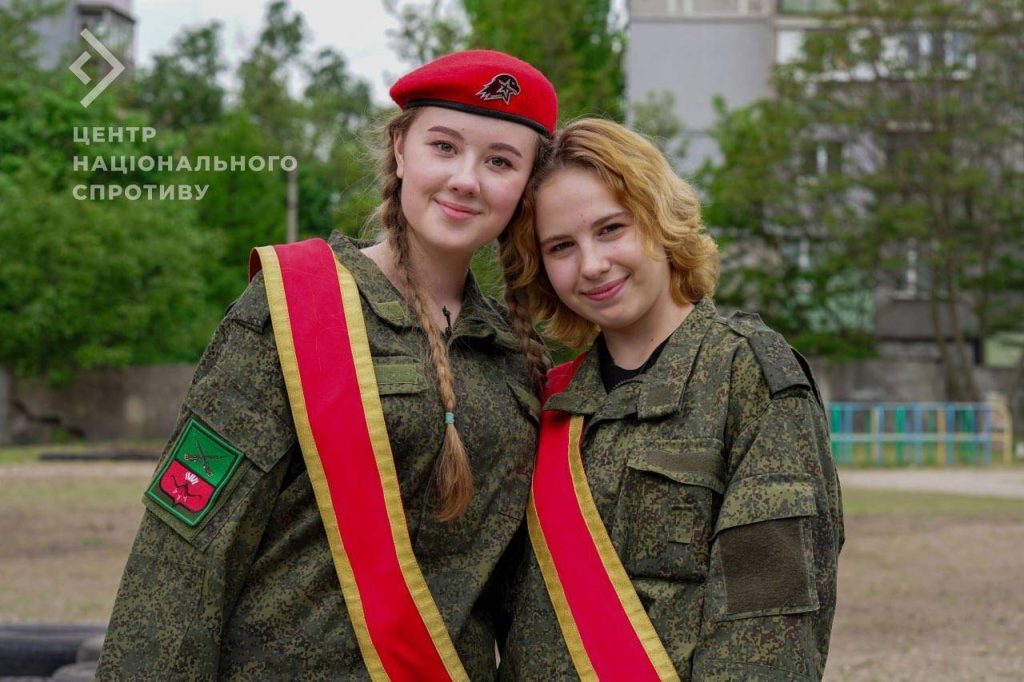
The judging was carried out by the “Warrior Center” which is personally supervised by Serhiy Kiriyenko. Representatives of the center “did not expect such zeal and preparation of the teams from Zaporizhzhia region and were pleasantly surprised by the high results of Zaporizhzhia boys.” Olena Trokay, head of the regional branch of the First Movement in the occupied part of Zaporizhzhia region, said: “After the regional stage, we will select the best, strongest team that will represent Zaporizhzhia region at the all-Russian stage.” She did not mention the regional stage in Volgograd.
Kherson region
Oleksandr Emelyanov, an employee of the central office of the “Firsts Movement” (probably a known collaborator from Luhansk region), confirmed that this year more than 600 children from Kherson region are participating in “Zarnitsa”. The competition covered four municipal districts: Henichesk, Skadovsk, Chaplynsk and Novotroitsk. At the same time, it was declared that the “largest stages” were to take place only in the first two districts.
The occupiers also boasted that last year, 16 children from Kherson region were involved in the “Zarnitsa” pilot project, and that last year “more than 2,000 children from the region took part in all-Russian youth projects.” In practice, this year’s “Zarnitsa” in the Kherson region was held on a much smaller scale than was declared.
Even the occupation media disinformation stated that “in the Kherson region… more than 250 people, united in 21 squads, [take part] in the municipal stages of the game.” According to the game’s rules, there should have been 10 people in each squad, so there were only 210 children at most.
And the rest of the “declared” participants were the organizers who were enrolled (for the sake of numbers) as participants. The invaders did not inform us about the regional (qualifying) stage, which is mandatory according to the game’s rules.
What’s next? Stalingrad…
The “LPR” reported that after their May regional stage of the “Zarnitsa 2.0” game, “two teams from two age categories will be selected” to go to the district stage in June in the Volgograd region. Teams from the “Southern Federal District”, which the occupiers have included Crimea and Sevastopol, and from the “new regions”, i.e. Donbas and Novorossiya, will compete there. The children-winners of “Zarnitsa” in the “DPR” (from Horlivka and Novoazovsk), from Kherson and Zaporizhzhia regions will be sent to Volgograd.
Volgograd Oblast, formerly called Stalingrad Oblast, is considered a federal or imperial center of “patriotic education.” The region has more than 160 military-patriotic clubs, nearly 500 clubs, more than 820 tourist and local history associations, and more than 250 cadet classes. In 2021, Volgograd schoolchildren won the “Zarnitsa”, which at the time was an “all-Russian children’s and youth military sports game.”


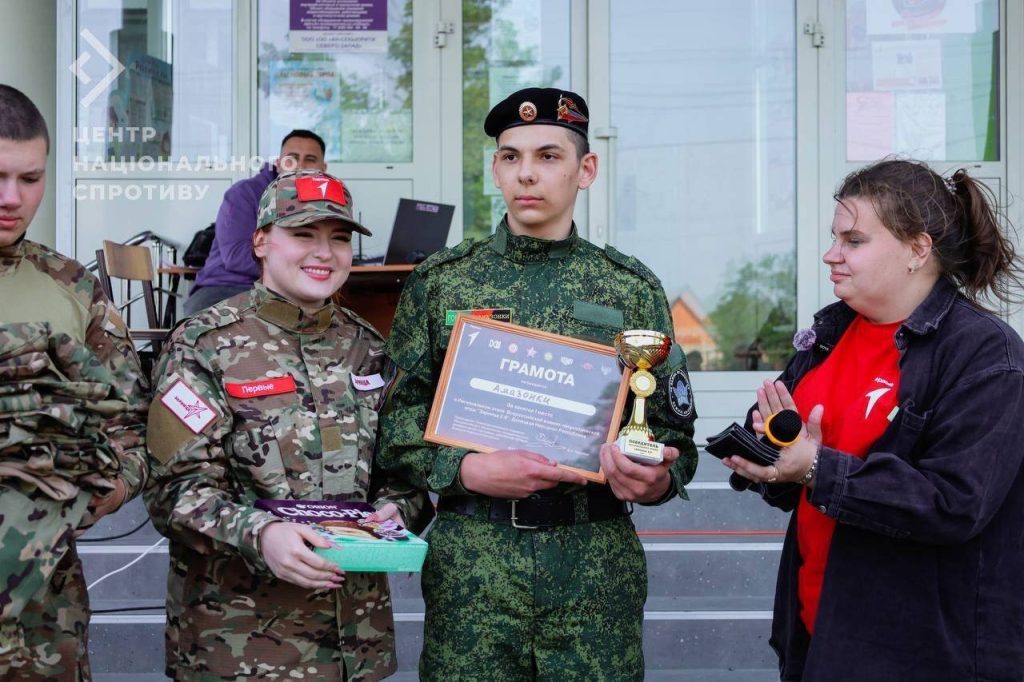
It was here last year, in August, during the piloting of the “Zarnitsa 2.0” project pilot, a team of children called “Wolves” from the Luhansk region arrived there and not only won a “military tactical game on the ground” but also took part in one of the shifts of the summer military-patriotic camp “Time of Heroes” held by the local branch of “Warrior” in Sredneakhtubinsky district based on a “youth defense and sports camp” under the typical name “Avangard” – initiated by Shoigu. This camp was built in a year and inaugurated on May 30, 2024.
This summer, the field shifts of the “Warrior” Center in Volgograd Oblast will involve all the finalists of the “regional” Zarnitsa 2.0 competition from the occupied territories of Ukraine. There will be groups of schoolchildren not only from the “LPR” but also from the “DPR”, Zaporizhzhia and Kherson regions. In addition to the Ukrainian regions, as well as the Russified Bilgordia (inhabited mainly by Cossack Ukrainian Sloboda regiments and which was part of the UPR in 1917-1919), the Moscow imperialists have also prioritized Kalmykia, which is also being ruthlessly Russified.
Viktor Vodolatsky, chairman of the board of the Warrior Center, a war criminal with the status of “State Duma deputy, Cossack general, and Hero of the LPR,” spoke at the opening of the Avangard camp near Volgograd: “This unique project was created by the Hero of Russia, the governor of the region, Andrei Bocharov. Our cadets, who came from 6 Russian regions and have been here for several days, are very happy.” In fact, most of them are children from the occupied territories of Ukraine.
And then Vodolatsky deciphered the imperial intentions towards the children of Kherson and Zaporizhzhia regions, the “DPR” and “LPR”: “For many years, they have been trying to educate them within the framework of the hostile, openly criminal Nazi ideology. Once on Stalingrad’s soil, these guys can personally familiarize themselves with the site of one of the main battles of the last century, study the facts recorded in authentic archival documents, and participate in excavations at the sites of legendary battles.”
In practice, the Warrior Center organized military combat training in engineering, tactical and firearms training, tactical medicine, UAV control and countermeasures, and parachute training for Ukrainian and Kalmyk children, winners of the “Zarnitsa 2.0” regional competition. The “educational zone” of the newly built federally funded training camp in Volgograd Oblast, where the Ukrainian children were brought, includes eight classrooms, four domed tents for lectures and workshops, a tactical field with engineering barriers, open shooting ranges, and a parade ground.
The newly built Avangard camp also has two multifunctional sports and playgrounds, a set of outdoor exercise equipment, a rope course, and an obstacle course. There is an open stage with stands, an art area, and park areas.
There is also a visitor center, a first-aid post, a dining room, a kitchen, a bath and laundry complex, and staff quarters.
Invaders know they are violating the Geneva Convention
This year, Ukrainian children from the occupied territories, but now in larger numbers – consisting of at least 24 teams of 10 people each – will again go to the Avangard camp in Volgograd Oblast, in the hands of the local branch of the Warrior Center. Obviously, not only the winning teams will be accepted, but also the runners-up.
Everything is free of charge. The main thing is to get the children to the camp, where last year the Luhansk team “Wolves” had already completed three weeks of pilot military combat training.
About 600 children have already arrived at the camp near Volgograd in the first days of June. That is, Ukrainian children are undergoing intensive military training these days, which the occupiers are carrying out in direct violation of Article 51 of the Geneva Convention:
“Any pressure or propaganda aimed at securing voluntary enlistment in the military service is prohibited.” Four shifts will be organized for about 2,500 children in the Volgograd region over the summer of 2024. The number of children planned to be recruited from the occupied territories of Ukraine is not disclosed in open sources.
The “DPR”, for example, did not publicly report on the “district stage” in Volgograd region, but spoke in general terms. According to the results of the municipal and “republican” stages, the best teams will be sent to the final of the game.
The “all-Russian stage” was declared to be held in September 2024, bringing together 640 of the best “fighters.” Schoolchildren from the middle age group (11-13 years old) will compete in a military tactical game on the ground, and the older age group (14-17 years old) will have a “big military tactical game.”
Similarly, in Sevastopol, the following stages were not publicly announced. It was only mentioned that in August 2024 “the grand final will take place, it will be held using the most modern gaming and digital technologies: unmanned aerial vehicles, ground drones, laser tag and firetag equipment.” Apparently, among other things, it was embarrassing to admit that the “all-Russian final” of the game would take place in the center of eastern Siberia, in the city of Irkutsk. And it will, in fact, take place in September.
The invaders, though not always publicly, are preparing Ukrainian children as cannon fodder for their war of aggression. The head of the Volgograd region announced his brainchild, the Avangrad camp near Volgograd, which in the coming years (similar camps are already under construction in the occupied territories) will specialize in children from Ukraine:
“We plan to build a Cossack education center in the next 3-4 years… and a flight training center… Everything has been started from scratch, practically in a clean field. All problems have been solved, and today, nothing prevents us from implementing the project. The center continues to develop, and in 3-5 years, you won’t recognize it – in stages, we will build a state-of-the-art center for multidisciplinary, multi-level, and comprehensive education of children and adolescents.”

